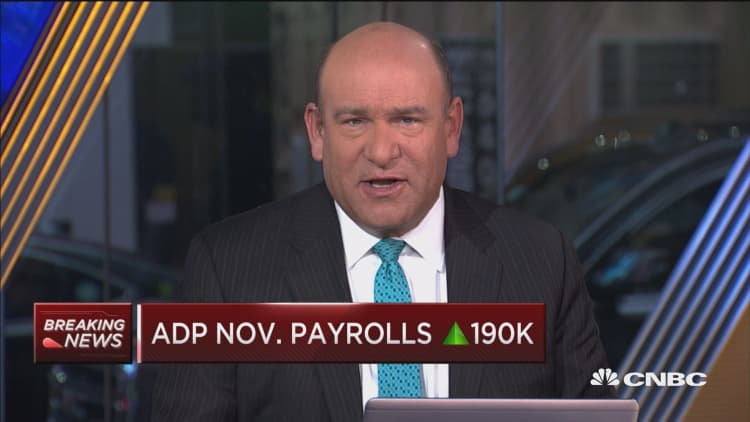
The manufacturing industry posted its best month of job gains all year, leading a better-than-expected rise in private payrolls during November.
Companies added 190,000 in the month as the economy seemed to return to normal following the violent hurricane season, according to the monthly report from ADP and Moody's Analytics. The total was just above the 185,000 expected from economists surveyed by Reuters and below the 235,000 growth in October.
The manufacturing sector added 40,000 positions alone.
"The job market is red hot, with broad-based job gains across industries and company sizes," Mark Zandi, chief economist at Moody's, said in a statement Wednesday. "There is a mounting threat that the job market will overheat next year."
The growth comes as the government's headline unemployment rate is at 4.1 percent, a 17-year low that economists believe will continue to decline. The Labor Department will release its closely watched official nonfarm payrolls count Friday, with economists expecting growth of 175,000 and the jobless rate holding steady.
"We're going sub-4 percent by this time next year, and that's an economy that could overheat," Zandi added in an interview on CNBC's "Squawk Box."
According to the ADP/Moody's report, the biggest jobs in November came from service-providing industries, which added 155,000, while goods-producing companies contributed 36,000 [the numbers don't add up to the 190,000 total because of rounding].
Aside from the jump in manufacturing, education and health services led with 54,000, professional and business services were next with 47,000 and trade, transportation and utilities contributed 36,000.
Information services saw a decline of 13,000 while construction fell by 4,000.
From a size standpoint, companies with 50 to 499 employees added 99,000, while small businesses contributed 50,000.
The ADP/Moody's count has shown private payroll growth of 208,000 a month this year. That's higher than the government's nonfarm payrolls average of 168,500, the slowest pace since 2011.
However, the numbers this year have been held back by the storm season as well as a feeling that the economy is nearing full employment, the point where most workers who want a job have one.
President Donald Trump has been pushing a pro-growth agenda of lower tax cuts, less regulation and higher infrastructure spending. He has promised to bring back many of the blue-collar jobs that were lost in the post-financial crisis recovery.
"The President would presumably want to take credit for the resurgence in manufacturing employment this year, but the synchronised global economic upturn and the weaker dollar are much bigger factors," Paul Ashworth, chief U.S. economist at Capital Economics, said in a note.
Federal Reserve policymakers have been watching the jobs situation closely. Central bank economists also believe the economy is nearing full employment, though wage pressures have remained muted. Average hourly earnings increased just 2.4 percent in October, and that's a number that will be closely watched ahead.
"As the labor market continues to tighten and wages increase it will become increasingly difficult for employers to attract and retain skilled talent," said Ahu Yildirmaz, vice president and co-head of the ADP Research Institute.
Traders expect the Fed to hike its benchmark interest rate a quarter point later in December, though the pace of increases in 2018 is less clear. The Fed has indicated three hikes are likely, but the market currently thinks no more than two moves are likely.


